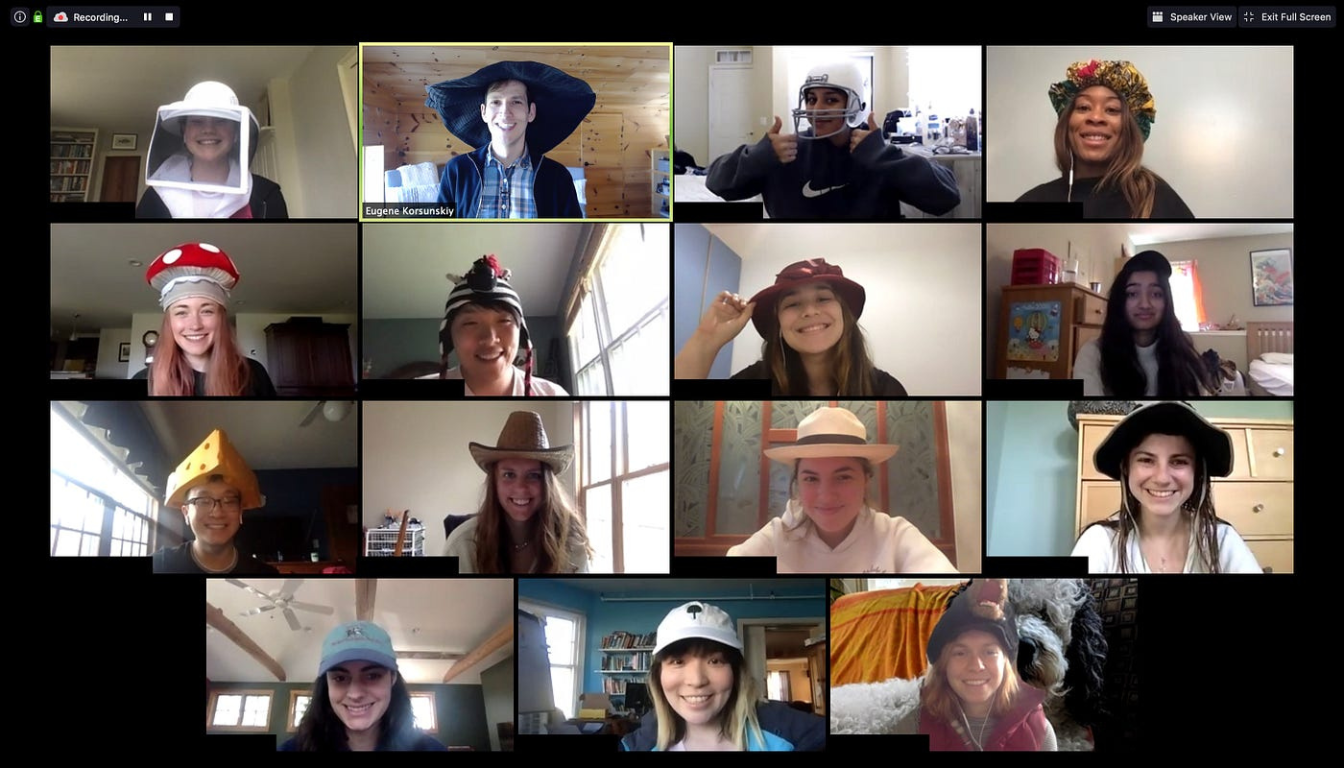Ice Breakers for Meetings: 29+ Ideas to Improve Virtual Meetings in 2022

Do you get sick of spending all day staring at a computer screen? Having to work remotely does not make it any easier. You start to long for face-to-face interactions, and that's why work retreats become so necessary.
During such retreats, your employees have the chance to build relationships with one another and feel more like a team. The good news is—they can also achieve this during online encounters. One of the ways to make this happen is to use some compelling ice breakers for groups during virtual meetings.
If you want to know what icebreakers are and how to use them to relax your employees during online team hangouts, keep reading!
What are Icebreakers?

Icebreakers are exercises used to familiarize teammates with one another. The purpose of these activities is to bring the team closer together by encouraging interaction, sharing interests, and getting to know each other better. This is especially important if people on the team aren’t familiar with one another but need to connect and interact to achieve good work results. Ice breaker questions are essential tools for fostering communication and building rapport within virtual teams.
Also, leadership activities such as icebreakers can be used in situations when people are meeting for the first time ever—online or in person. This type of conversation can ease their social anxiety and help everyone feel more at ease around one another.
Icebreaker activities can be split into several different categories—age-based, business-type, and small and large group-based. Each of these can include various questions, guessing games, quizzes, and other types of absorbing activities the team may find fun and interesting.
Definition and Purpose of Virtual Icebreakers
Virtual icebreakers are interactive activities designed to help remote teams build connections, establish relationships, and create a sense of community in a virtual environment. These activities are essential for breaking down communication barriers and fostering collaboration among team members who may be scattered across different locations.
The primary purpose of virtual icebreakers is to create a more engaging and interactive virtual meeting experience. By incorporating these activities, remote teams can overcome the challenges of physical distance and develop stronger bonds. Virtual icebreakers encourage team members to share their interests, participate in fun activities, and get to know each other better, ultimately leading to improved team morale and productivity.
How Do Icebreakers Help Virtual Teams?
The biggest benefit of icebreakers is that they can help create a more relaxed atmosphere during your virtual meeting.
Online meetings have many restrictions. To begin with, building relationships with individuals you only see on a screen is more difficult. Additionally, it is hard to convey your feelings to them, which can make conversations less engaging.
Besides that, many people experience nervousness when participating in virtual meetings. They frequently give extra thought to their appearance and how they come across to others. For this reason, they might also feel physically anxious or even exhausted after the meeting.
Icebreakers are meant to get rid of these not-so-pleasant emotions or experiences among teammates and foster a more laid-back and comfortable environment. They promote interpersonal warmth by allowing your employees to get to know one another and participate in numerous fun games and other activities, which is essential for team bonding.
Virtual ice breakers can enhance team bonds during remote meetings by creating enjoyable interactions that strengthen relationships among team members.
The more people get to connect with one another, the better they will get at communicating, which will improve teamwork and be advantageous to the entire company.
Improving Team Morale and Bonding

Virtual icebreakers play a crucial role in boosting team morale and bonding among remote team members. By encouraging participation, creativity, and interaction, these activities can help to:
- Reduce feelings of isolation and loneliness: Working remotely can sometimes feel isolating. Virtual icebreakers provide an opportunity for team members to connect and share experiences, making them feel less alone.
- Increase team cohesion and collaboration: When team members engage in icebreaker activities, they learn more about each other’s strengths and interests, which can lead to better collaboration on work projects.
- Improve communication and rapport: Regularly participating in virtual icebreakers helps team members become more comfortable communicating with each other, leading to more effective and open conversations.
- Boost team morale and productivity: Fun and engaging activities can lift spirits and create a positive atmosphere, which can translate into higher motivation and productivity.
- Create a sense of community and belonging: Virtual icebreakers help build a sense of community within the team, making everyone feel like they are part of something bigger.
By incorporating virtual icebreakers into virtual meetings, remote teams can build stronger relationships, improve team dynamics, and achieve better outcomes.
Types of Virtual Icebreakers
Virtual icebreakers come in various forms, including games, quizzes, activities, and questions. Here are some examples of different types of virtual icebreakers:
Short Virtual Icebreakers
Short virtual icebreakers are quick and easy to participate in, making them perfect for busy remote teams. These team building virtual activities can be used to break the ice, create a relaxed atmosphere, and get team members engaged and interacting with each other. Examples of short virtual icebreakers include:
- Two Truths and a Lie: Each team member shares three statements about themselves—two truths and one lie. The rest of the team guesses which statement is the lie.
- Would You Rather: Pose fun and thought-provoking “Would you rather” questions to the team, encouraging them to choose between two options.
- Guess the Song: Play a short clip of a song or hum a tune, and have team members guess the song title.
- Virtual Scavenger Hunt: Create a list of items for team members to find around their homes within a set time limit. The first person to find all items wins.
Fun Virtual Icebreakers

Fun virtual icebreakers are designed to be entertaining and engaging, making them perfect for remote teams looking to have some fun and build relationships. These games for team engagement can create a more relaxed and informal atmosphere, encouraging team members to let their hair down and build stronger bonds. Examples of fun virtual icebreakers include:
- Virtual Escape Room: Team members work together to solve puzzles and escape a virtual room within a set time limit.
- Online Games: Play popular online games like Pictionary, trivia, or word games that everyone can enjoy.
- Virtual Karaoke: Host a virtual karaoke session where team members can sing their favorite songs and enjoy some laughs.
- Virtual Cooking Class: Arrange a virtual cooking class where team members can learn to cook a new dish together and share their culinary creations.
By incorporating virtual icebreakers into virtual meetings, remote teams can create a more engaging, interactive, and fun experience that fosters collaboration, creativity, and connection.
How to Implement Icebreakers the Right Way
Now that we know why icebreakers are important, let's check out some tips that can help you properly implement icebreakers in your virtual meetings.
- Know when to use icebreakers. Not every meeting is suitable for these. Some meetings might be more serious than others, and some people might click with one another well enough even without them. Therefore, always feel the surroundings before acting.
- Space icebreakers out. Don't try to use icebreakers at every single meeting. They will become redundant, and chances are they will no longer be effective when you really need them.
- Have a backup plan. You should always have a fallback strategy in case one of your icebreaker suggestions doesn't work. You don't want to find yourself in a situation where people expect to have some bonding time but you can't do anything else to help them connect with one another.
- Know your team. Keep your team in mind while deciding on the type of icebreakers you should use. Will they be comfortable participating in these activities? How far will they need to step outside of their comfort zone? Additionally, keep an eye on them as they engage with these icebreakers so you can determine if anything else needs to be done to make them even more comfortable. Ensuring diversity and inclusion in your activities is essential to creating a welcoming and respectful environment for everyone.
19 Examples of Icebreaker Questions

We now know how to use icebreakers correctly, so it's time to finally show you some icebreaker questions you can use in your virtual meetings.
#1. Where are you joining from?
This is an excellent question to ask at the beginning of an online meeting, especially if you work with remote teams where people may be dispersed all around the globe.
Knowing where each of them is coming from can encourage them to communicate and ask additional questions about one another's cultures and backgrounds. Needless to say, this will make everyone feel more relaxed and spark some interesting conversations.
#2. Would you rather?
“Would you rather” questions belong to the ones you can ask right after the basic introductions to help your teammates open up. These tend to be less serious and more humorous than regular “about you” questions, which automatically makes them more enjoyable and fun.
Here are some of the “would you rather” questions you can ask:
- Would you rather be rich and unhappy or poor and happy?
- Would you rather never say yes or never say no again?
- Would you rather be always cold or always hot?
#3. Random questions
Random questions are team building questions that are not only fun but also thought-provoking. Let's see some examples:
- What would you do with a million dollars?
- What's on your bucket list?
- What superpower would you like to have and why?
- If you could be a fruit, what would you be?
- If you could meet any person—dead or alive—who would you meet with?
- What's your stance on pizza with pineapple?
- If you could travel in time, would you choose to visit the past or the future?
- What are your favorite emojis?
- What is the fashion decision you regret the most?
- If you had to say no to one food item for the rest of your life, which food item would you be willing to sacrifice?
- If you had to either say yes to everything or say no to everything, which one would you pick?
- You have been appointed the president of your home country for the entire day. What is the first thing you are going to do?
- What is the first thing you would do if you could switch genders for a day?
- If you could be reborn as an animal, which animal would you choose?
- If you were to be stranded on an island, which three items would you take with you?
10 Examples of Icebreaker Games
#1. Two truths and a lie
“Two truths and a lie” is a fun and common icebreaker for Zoom meetings, and it's perfect for teammates who don't really know each other well.
Each player shares three statements about themselves. The statements can be about anything, such as their favorite color or the number of dogs they own. One statement must be a lie, and the group then makes guesses as to which statement is not true.
This game for team building is more time-consuming than other games, which is why it's best to play it in smaller groups. This way, everyone on the team will have time to provide three "facts," and then everyone else can speculate.
#2. Name that tune
Music has a way of bringing people together. So why not incorporate it into a game?
You can take turns choosing a song to demonstrate in a big or small group. You can do whatever comes to mind, including humming, tapping, clapping, or using an instrument. The rest of the team is expected to guess the song you are demonstrating.
This game can be a little challenging, but if you pick well-liked or popular tunes, everyone should be able to pick it up pretty quickly!
#3. Guess who?
Looking for some fun icebreakers for meetings that aim to cheer people up? Search no more—you definitely want to play “guess who!”
Essentially, every person is given a role to play—it can be a famous person or even one of their fellow team members if they know one another well enough. Once they imitate the person they have been assigned, the rest of the team can guess who they think it is.
This game might be a little challenging and time-consuming, but on the other hand, it's perfect for large teams or even small teams with established relationships.
#4. Virtual scavenger hunt
Scavenger hunts are quite fun, and the ones organized virtually are no exception.
For this purpose, you should divide the team into smaller groups. They can be given a list of various items to find around their homes. You set a time limit for them, and by the end, the things need to be prepared for display. The group that finds more items wins.
This problem solving exercise is one of the large group icebreakers where people get to work together. To spice up these activities, you can also use a riddle icebreaker for meetings like these—they will definitely make the game more challenging and thought-provoking.
#5. Virtual icebreaker bingo
Virtual icebreaker bingo is ideal for large groups because there are no restrictions on the number of players.
Using a bingo generator will make it easier for you to create squares with different statements, such as "Knows how to surf" or "Can read tarot cards."
Once the team members have marked the squares that apply to them and things they can or have done, you can ask them to say what they have marked and encourage them to share any interesting stories that go with each statement in the square.
By listening to their teammates and sharing some interesting information about themselves, all players will get a chance to get to know one another better and strengthen collaboration.
#6. Virtual charades
Charades is an ideal game for large groups because it requires multiple teams to compete against one another.
Each team must have a minimum of two members so that one can act out the noun from a selected category while the other is supposed to make the correct guess. This way, the teammates will have an opportunity to bond over a game that is both fun and enjoyable. Virtual team building activities like charades can build communication and relationships within remote teams.
#7. Trivia quiz
A virtual trivia quiz is always a good idea if your team enjoys quiz nights.
The team can be split into smaller groups, and each group's goal is to answer as many trivia questions as possible. They get more points for each correct answer, and the team with the highest score wins. The benefit of this game is that it can be played for sheer entertainment or for educational or informational purposes.
#8. Most likely to…
The “most likely to…” indoor team building activity is great for teammates who are somewhat familiar with one another.
You can come up with questions on your own or scout the Internet and find different "most likely to" questions on websites like Parade, Algrim, and even Cosmopolitan.
Once you have the questions ready, you just read them out, and the team members state who they think the title should go to. For example, you can ask who's most likely to break a world record, eat something off the ground, or marry a celebrity, and whoever gets named the most will take the title for that question.
To ensure that everyone feels involved, only assign one title to each person.
#9. Guess the childhood photo
If you are looking to have a wholesome virtual meeting, you'll find the “guess the childhood photo” icebreaker perfect for the occasion.
Ask employees to send you their childhood photos. Once they do it, you can combine them in a slideshow and share it with the team during the meeting. As the photos are shown, you are supposed to guess who the baby in the photo is from among your teammates. Of course, make sure to contain your smile so that you don't give much away!
#10. In one word, how would you describe…?
Have you ever played "In one word, how would you describe...?" This team building activity might not be as popular as charades or “never have I ever,” but it's always fun and engaging.
Ask your team members to use one word to describe how their week was, how they are feeling right now, what they think about climate change, and so on.
How you fill in the blank at the end of a sentence depends on what you want to accomplish as the team leader. If you want to make sure everyone is happy, you can focus on how they are feeling right now. If you want to know what their opinions about different topics are, you can choose a category like "climate change" or something similar.
9 Other Examples of Icebreaker Activities
Do you need more fun icebreakers for virtual meetings with your team that don’t belong to the categories above? Virtual holiday work games help to alleviate awkwardness during virtual meetings by enhancing communication and bonding among team members. We’ve got you covered—here are some more ideas you can use for this purpose!
#1. Choose your favorite…
“Choose your favorite” is not a challenging icebreaker activity, which means that the participants can focus on having fun and enjoying the process. As the team leader, you invite your members to select their favorite show, book, song, meal, or anything else, and if everyone is up to it, they can comment on their choices or discuss them with other people on the call. Virtual team icebreakers like "Choose Your Favorite" can boost performance and engagement among remote employees working in sales.
You can use this as a warm-up activity at the start of every other meeting, with a different topic each time. It’s a quick and easy game that doesn’t require much time or effort, but it works well if you want to introduce team members to one another or start a conversation.
#2. Share your workspace
The workplace can reveal a lot about an individual’s personality and interests. While some people love order, others easily remain productive in a chaotic environment. These differences can be quite interesting, as well as finding out under what conditions your teammates work.
The “share your workspace” activity is another short virtual icebreaker that allows team members to showcase their workspaces and say what they enjoy about them. This way, your team members will get to know some new things about their coworkers and learn more about them in a fun and interesting way. Virtual meeting ice breakers like 'Share your workspace' facilitate conversation during virtual meetings and even virtual retreats.
#3. Show and tell
Another simple yet entertaining activity you may incorporate during your virtual meeting is “show-and-tell.”
In essence, you ask each member of your team to select an object and display it for the group. You can choose particular categories to give it more structure. For example, you can ask your team members to select an object from their living room, find an item that is red, pick their favorite book, and so on.
The interesting part here is that people get to talk about these items and their meaning or importance. This means that you will probably hear some interesting and maybe even funny stories related to the items. Needless to say, this is also a great way to learn more about what your colleagues are interested in. Virtual team activities like 'Show and tell' promote team bonding and boost morale even during retreats.
#4. Draw your mood
Drawing your mood is a unique virtual icebreaker that allows the entire team to get a piece of paper and a pen and draw how they are feeling at the given moment. Virtual games like 'Draw your mood' enhance team engagement and interaction.
When they draw, they can be as creative as they wish. For example, they can draw something abstract or even recreate a well-known piece. Once done, you can ask your team to show what they drew and explain how their art relates to their current moods and feelings.
This opportunity to express how they are feeling will be therapeutic for your team and allow them to either keep the great energy going or get rid of the negative one. As an alternative, you can also organize team building mural activities to foster creativity.
#5. Been there, done that
Similar to “never have I ever,” this game highlights not only players’ creativity but also their courage and confidence in sharing personal details that not many other people may be aware of.
Essentially, as the team leader, you should prepare a list of questions to which your team members will answer “been there, done that” if they have done the thing you are asking about or stay silent if they haven’t.
Make a list of questions that everyone can answer and choose topics that everyone is comfortable with so that everyone is willing to take part. Video call activities like 'Been there, done that' foster connections and ease anxieties.
#6. Common ground
Finding common ground with your teammates is one of the best ways to develop a more meaningful relationship with them.
This icebreaker activity is recommended for teams that don't really know each other. You will be able to tell who is passionate about what by choosing a topic and having a discussion about it. On top of that, they’ll also have the chance to learn more about their coworkers’ preferences and personalities, which helps promote a positive company culture.
#7. Say it with an emoji
Emojis are great for communication. So why not use them as icebreakers for virtual meetings?
All you need to do is ask your team members a question and let them respond with an emoji. For example, you can ask, "What emoji best shows how you feel right now?" or "What emoji would you use to say no?"
#8. 18 & under
A game called 18 & Under is made to help you connect with new people. To make it work, you should ask each team member to share their greatest accomplishment from before the age of 18. This way, each of your teammates will get a chance to speak and reveal something about themselves that they are proud of.
This employee engagement strategy is exciting since it enables you to learn more about the people you are interacting with by hearing about their interests and accomplished goals. It also allows you to express admiration for their visions and encourage them to further pursue their dreams.
#9. Last picture you took
Most people regularly snap photos to immortalize different moments. So, why wouldn't you share some of them with your coworkers?
Choose the last photo in your gallery, show it to your teammates, and explain the story behind it (if there's any). Once you do it, encourage everyone to share their own pictures. For example, if it's a picture of their pet, they can tell everyone a little bit about it, such as their name, age, breed, etc.
Tired of Virtual Meetings? Offsite Can Help You Organize Your Next Retreat!
We know how tiring virtual meetings can get. Zoom fatigue is no joke.
It is a terrific idea to bring your staff together in real-world, face-to-face settings in order to break the cycle. And what better way to accomplish this than by organizing a retreat?
Here at Offsite, we are aware of the time and effort required to plan a retreat, and we're here to assist.
All you need to do is provide us with some general information, including the guest list, retreat objectives, the budget, and location preferences.
Once you do it, our team will take care of everything. We will provide you with everything you'll need for a successful retreat, starting from sending out invitations and choosing vendors and locations to arranging activities and providing post-retreat feedback.
Worry no more—visit Offsite and organize your next corporate retreat without breaking a sweat!
Closing Thoughts
So, here we have it… 29+ entertaining icebreakers to improve virtual meetings in 2022, just for you!
It can be quite stressful and intimidating to work online all the time and participate in online meetings. Not to mention that the team may lack cohesiveness and connectivity in such circumstances.
Luckily, that’s where virtual meeting icebreakers come in, with companies like Offsite providing fun and engaging ways to help remote teams connect.
They will help you create a more laid-back atmosphere where individuals can communicate and open up more. Needless to say, this will strengthen relationships within the team and boost productivity in no time!
FAQs
You may also like
Unique spaces for your next offsite
Find distinctive venues for your upcoming corporate retreat.
Stay Updated with Our Insights
Get exclusive content and valuable updates directly to you.







